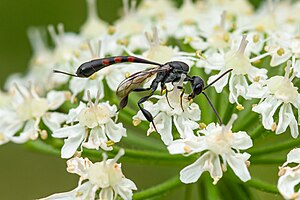Gasteruptiidae
| Gasteruptiidae | ||||||||||
|---|---|---|---|---|---|---|---|---|---|---|

Gasteruption sp. |
||||||||||
| Systematics | ||||||||||
|
||||||||||
| Scientific name | ||||||||||
| Gasteruptiidae | ||||||||||
| Kirby , 1837 |
The Gasteruptiidae , sometimes also called "narrow-bellied wasps" or "gout wasps" (after the swollen tibiae), are a family of hymenoptera. Their larvae are parasitoids / kleptoparasites of solitary bees, more rarely honey wasps and digger wasps. The approximately 500 species are distributed worldwide.
features
The animals are noticeably narrow and elongated with long legs. They are almost always black in color, in many species the legs or parts of the abdomen are reddish brown or red. It is typical of the superfamily of the Evanioidea that the free part of the abdomen on the propodeum does not start between the rear hips, but is noticeably higher. The Gasteruptiidae are almost unmistakable within the superfamily by a number of features. The round to oval head is set off from the thorax with a clearly elongated "neck" region and has large complex eyes. The thread-like antennae are deflected at about the level of the middle of the eye, they consist of thirteen in the male and fourteen in the female. On the trunk, the front section (prothorax) is very short and hardly visible from above. The hind legs are noticeably strong and significantly longer than the front pairs of legs, the rails (tibia) of the hind legs are strongly swollen towards the end in a club-shaped manner. The clear wings are folded lengthways in the rest position (convergence to the wasps ) and placed on top of each other. The narrow, cylindrical abdomen is usually somewhat thickened towards the end and is usually curved upwards in a sickle shape. At the end of the female there is a long and thin ovipositor, the sheath protruding backwards, the length of the ovipositor differs depending on the species, the maximum it is about body length. In many species the ovipositor sheath has a strikingly white transverse band towards the end.
Way of life
The females of the Gasteruptiidae lay their eggs in the burrows of solitary bee species that nest in wood or plants. If the brood cell is already closed by the bee, they pierce the lid with the ovipositor. Depending on the species, the egg is deposited on the host egg, on the pollen store or somewhere in the cell. The hatching larva eats the host's egg or larva, depending on the species, and the food supply that has been collected. If necessary, it can penetrate into neighboring brood cells in order to continue feeding here. The fully grown larva then pupates in the bee cell, where it may overwinter. As host species have become known u. a. Species of the genera mask bee ( Hylaeus ), silk bee ( Colletes ), holey bee ( Heriades ), mason bee ( Osmia ), scissor bee ( Chelostoma ), cudhorn bee ( Ceratina ), spiral horn bee ( Systropha ) and wooden bee ( Xylocopa ). Evidence of digger wasps ( Crabronidae ), solitary folded wasps ( Eumeninae ) and honey wasps ( Masarinae ) are given, but are doubted by many authors because there may be confusion here (bees nesting in the same place), at least for some non-European species these are Hosts proven. Like their hosts, wasps can train a generation or two a year.
The full-grown wasps are often found on flowers, but due to the very short and not trunk-like protruding mouthparts, they only contain plant species with open nectar such as z. B. umbelliferae can use. The species that occur here fly in summer.
Systematics
The Gasteruptiidae are classified in the superfamily Evanioidea. In the opinion of all authors, their sister group are the Aulacidae , with which they have even occasionally been united in a family.
The family is divided into two subfamilies
-
Gasteruptiinae .
- Gas eruption (distributed worldwide, more than 400 species, 16 of them in Germany)
- Plutofoenus (3 species, South America)
- Trilobitofoenus (3 species, South America)
- Spinolafoenus (1 species, South America)
-
Hyptiogastrinae . Only in Australia (and surrounding islands), two also in South America. Hosts are ground-nesting bees. Recognizable by the very large mandibles that overlap at rest, the short, often hidden ovipositor and features of the wing veins.
- Hyptiogaster (10 species). only in australia.
- Pseudofoenus (80 species)
Web links
swell
- John T. Jennings & Andrew R. Deans: Gasteruptiidae. Tree of Life web project
- Antonio Carlos Cruz Macedo (2011): A revision of Gasteruption Latreille (Hymenoptera: Gasteruptiidae) in the Neotropical Region. Zootaxa 3030.
- Ingmar Wall (1994): Rare Hymenoptera from Central, Western and Southern Europe (Hymenoptera Apocrita: Stephanoidea, Evanioidea, Trigonalyoidea). Entomofauna Volume 15, Issue 14: 137-184.
- ↑ John T. Jennings (1999): Systematics and biogeography of Hypogastrine wasps (Hymenoptera, Gasteruptiidae). Thesis, University of Adelaide.